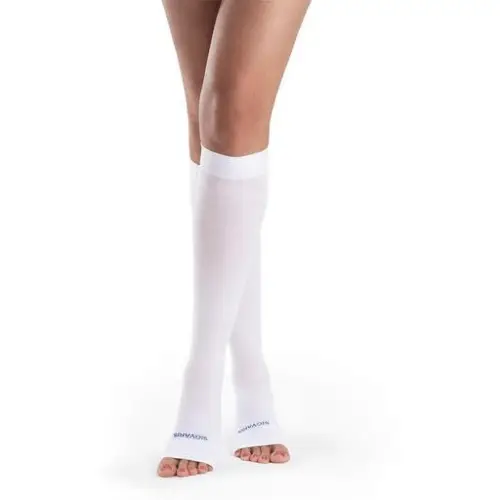TED hose and compression stockings are specialized types of hosiery designed for the same purpose: compression. But despite their similarity, there are a variety of factors that set them apart.
Summary Table
| TED Hose | Compression Stockings |
| Designed to prevent blood clot formation | Designed to improve blood flow in the lower extremities |
| Ideal for post-operative or non-ambulatory (immobile) patients | Ideal for patients with mild venous conditions like lymphedema (lymph accumulation that leads to swelling), varicosity, and venous insufficiency |
| Compression level: around 8 to 18 mmHg | Classified into three compression levels: 30-40 mmHg, 20-30 mmHg, and 15-20 mmHg |
| White stockings designed with a small opening near the toes | Available in a wide range of style and color |
| Usually used for 3 weeks | Usually used for 6 months, depending on the doctor’s recommendation |
Definitions

TED hose, medically known as thrombo-embolic deterrent hose, are anti-embolism stockings designed to put pressure on the superficial veins to prevent blood clot formation.

Compression stockings are tight-fitting stockings that put a specific level of pressure on the lower extremities.
TED Hose vs Compression Stockings
Although these specialized kinds of hosiery seem similar, there is a huge difference between TED hose and compression stockings, especially in terms of design and use.
Purpose
Both are used for leg compression, but they do so for different purposes. TED hose are designed to prevent blood clot formation, also called embolism, for post-operative or non-ambulatory (immobile) patients. It does so by preventing blood from pooling in certain parts of the limb. This lowers a person’s risk of developing blood clots, which can cause serious medical complications.
Compression stockings, in contrast, mainly function to improve blood flow in the lower extremities, especially for conditions that require an aggressive form of compression. Mostly prescribed for ambulatory (mobile) patients, the use of compression stockings is an important part of treatment plans for mild venous conditions like lymphedema (lymph accumulation that leads to swelling), varicosity, and venous insufficiency.
Level of Compression
Compression levels for both TED hose and compression stockings are measured in mmHg (millimeters of Mercury). Between the two, TED hose usually has a lower compression level at around 8 to 18 mmHg. Compression stockings, on the other hand, are usually classified in three compression levels: 30-40 mmHg, 20-30 mmHg, and 15-20 mmHg. As a rule of thumb, patients that require compression levels higher than 20 mmHg need to obtain a physician’s prescription.
Design
Since TED hose and compression stockings function differently, they also have marked differences in terms of design. Unlike compression stockings that are available in a wide range of style and color, TED hose are white stockings designed with a small opening near the toes. This facilitates blood circulation monitoring.
Additionally, the design structure of TED hose and compression stockings make them ideal for non-ambulatory and ambulatory patients, respectively. For one, the compression structure of TED hose changes as the stockings move up the legs, making it unideal for mobile patients.
Duration of Use
The length of use of either type of hosiery depends from one case to another. But in general, TED hose are made for short-term compression. Usually, patients are required to use TED hose for 3 weeks or until another form of blood clot prevention is available. Compression stockings, by contrast, can be used for up to 6 months, depending on the doctor’s recommendation.





